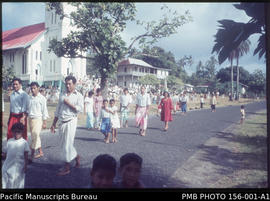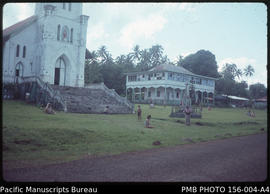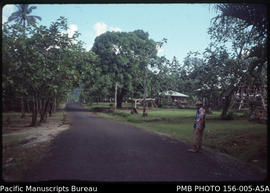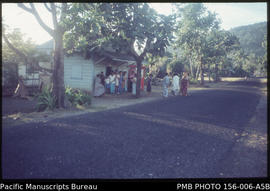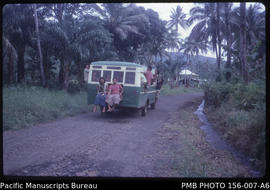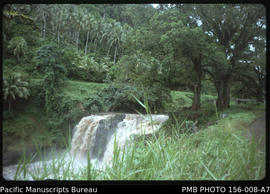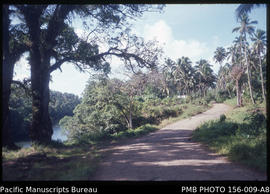Identity area
Reference code
AU PMB PHOTO 156
Title
Date(s)
- 1975 - 1982 (Creation)
Level of description
Collection
Extent and medium
134 digitised 35mm slides
Context area
Name of creator
Biographical history
Since 1966 Robert Norton’s major area of research has been ethnicity and politics in Fiji. His PhD thesis, Politics, race and society in Fiji, was submitted at Sydney University in 1972. His book, Race and Politics in Fiji, was published by the University of Queensland Press in 1977 and a revised second edition was published in 1990. He was appointed as one of the foundation members of staff in the Department of Anthropology at Macquarie University in 1969. He continued to be a consistent observer and respected commentator on Fiji politics throughout his academic career, writing many essays and articles on politics in Fiji in scholarly journals and books.
Repository
Archival history
Immediate source of acquisition or transfer
Content and structure area
Scope and content
This is a collection of 134 digitised slides of Falefa, on the northeast coast of the island of Upolu, 20 km from the Samoan capital Apia. With a population in recent years of over 1500, Falefa comprises four ‘sub’ villages - Sagapolu, Saleapaga, Gagaemalae, and Sanonu. Its leading matai [chiefly] ali’I titles Leutele and Salanoa and leading tulafale [orator] titles Moeono and Iuli figure prominently in Samoan political history, particularly in relation to the district title Tui Atua, and Tama Aiga titles Tupua Tamasese and Mataafa.
The photographs were taken in Falefa by Robert Norton during four periods of sociological field research - October 1975-January 1976, August-September 1977, December-January 1980, February 1982. Norton was studying aspects of social and political change, particularly influences of the growing remittance economy. The large scale emigration of Samoans to New Zealand for wage employment was encouraged by the hurricane destruction of banana plantations in 1966 and an increasing need for industrial labour in New Zealand. Norton began his research in Falefa just nine years after the commencement of this exodus of young people to earn money to send home.
Many of the photos illustrate the changes in housing underway funded mainly by remittances in the early years of the labour emigration. A family’s success in establishing members in New Zealand’s work force was soon displayed and measured by the construction of modern houses. The change had slowly begun some years before the labour emigration wave, but was greatly accelerated by it.
Some families were a lot more successful than others in their access to remitted funds, having established several members in overseas employment. So the new era of migration and remitting brought a new dimension of economic and social inequality in the village. The inequality was sometimes quite stark in housing contrasts even between different households of the same aiga [land-owning descent group] - Traditional fale [houses] were still common in the village. Some families also used the new income to make a strong showing in their funding of fa’a’lavelave - important and expensive events such as weddings, matai title bestowals, funerals, and church dedications. The new source of economic inequality led to new dependencies between different households within an aiga.
Remittance income to village families was spent to a lesser extent in capital investments in plantation production, copra driers, utility vehicles etc; Vehicles were very few in the village during the 1970s [around half a dozen]. Although some people became successful entrepreneurs on their aiga land with the aid of remittances, more became less interested in their plantations and more contemplative of anticipated regular money gifts from emigrant family members.
Before the labour emigration wave, money income was gained mainly by the sale of produce from the land and sea [taro and other root vegetables, coconuts and copra, fish]. A few households included members with salaried jobs in town or in the village itself [the school, and the health centre], and several maintained small shops with everyday commodities purchased in Apia, Samoa’s main town. Travel to Apia 20 km to the west was mainly by bus - to schools, to visit and attend social events in other villages, or for shopping or visits to government offices, banks, hospital, lands and titles court etc
Norton also gave particular attention to leadership and authority, eventually publishing an academic paper on electoral politics at the village level. To enable him to sit with the matai [aiga titled chiefs] in the village fono [council] meetings he was given an honorary title.
Many of the photos were taken at Fono meetings - at village, sub-village, and inter-village levels. Some photos are of a Fono meeting functioning as a court hearing and judging minor disputes and imposing fines. These photos are restricted access. Norton himself once faced the prospect of attracting a fine that would be levied on the matai head of his host household if he refused to remove his beard. The village fono had for a year or two decreed it an offence for men to grow beards or long hair and for women to wear slacks. The rule expressed tension between the Fa’a’Samoa [Samoan way] and the Fa’a’Palagi [European way] that had strengthened a little with the impact of the labour migration, not just on material living conditions and social competition, but on popular consciousness, particularly in the youths who became accustomed to interactions with emigrants returning to the village for important social celebrations and to display their successes and tell stories about life in New Zealand. Norton didn’t hesitate to shave for the duration of his short stay in 1977. But by his next stay three years later the anti-beard rule had been dropped.
Appraisal, destruction and scheduling
Accruals
System of arrangement
As arranged by Robert Norton.
Conditions of access and use area
Conditions governing access
See individual items
Conditions governing reproduction
Language of material
Script of material
Language and script notes
Physical characteristics and technical requirements
See individual items
Finding aids
Allied materials area
Existence and location of originals
Person: Robert Norton
Address: Sydney, NSW
Country: Australia
Existence and location of copies
Access this title at PMB Member Libraries or by contacting the Bureau directly: http://asiapacific.anu.edu.au/pambu/accessing.php
Related units of description
Notes area
Note
Captions, Scope and Content supplied by Robert Norton
Note
See also PMB PHOTO 103: Slides and photographs of election campaigns during 1966 election in Fiji; PMB MS 1228: English translations of political speeches in Fiji; PMB MS 1234: Research papers on Fiji politics and PMB MS 1370: Research papers on Fiji politics
Alternative identifier(s)
Access points
Subject access points
Place access points
Name access points
- Norton, Robert (Subject)
Genre access points
Description control area
Description identifier
photo156
Institution identifier
Rules and/or conventions used
Dates of creation revision deletion
Language(s)
Script(s)
Sources
Digital object metadata
Filename
Digital_reference_image.pdf
Latitude
Longitude
Media type
Text
Mime-type
application/pdf
